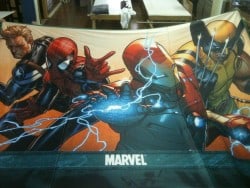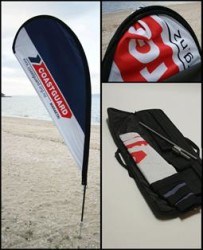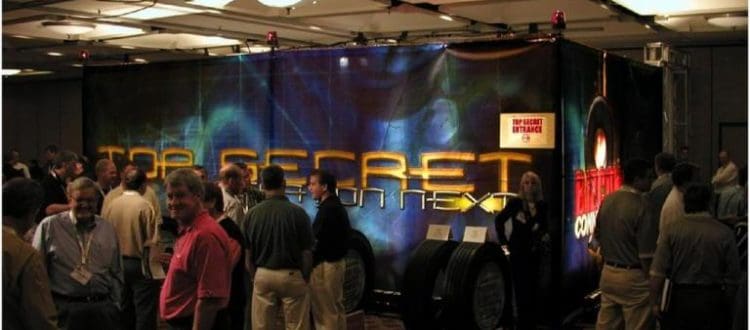This is how you can commercially use dye sublimated fabric banners. Read full article below.
Question: In what commercial applications are dye sublimation printed cloth or fabric used?
There are quite a number of applications for dye sub printing on fabric/cloth, most of which are commercial at some level, although some products like shirts end up on retail store display racks and shelves.
Commercially, though, where an end user is using the actual printed fabric, there are still a lot of applications we can talk about. However, for those who are new to this discussion, let me first re-explain what dye sublimation printing is and how it’s done. I enjoy this topic, and for me it keeps it fresh in my mind to go over it every month or two, and that way, you don’t have to go back in our blog to learn about how it’s done and some of the science behind it.
First, let me say that someone or several people who developed this type of printing were/are way smarter than I am. I mean, who really sits around and thinks, “Gee, if I combine heat and pressure and dye, I can make some seriously beautiful printing!”
 It’s a bit like who thought of making computers using silicone? And really, what is silicone, and how could anyone even think about using it to create this laptop that I’m typing this article on?
It’s a bit like who thought of making computers using silicone? And really, what is silicone, and how could anyone even think about using it to create this laptop that I’m typing this article on?
Fortunately for you and I, though, we don’t have to invent or re-invent dye sub printing, or really even to improve on it (although that is being done as well by more people who are way smarter than I am!).
Dye Sublimation Printing
However, I do understand the hows and whys of digital dye sublimation fabric printing, and I am happy to share this information with anyone who asks.
How the Dyes Differ
First, and while I don’t know why “dye” is different than “ink,” and am personally suspicious that the designation is simply to distinguish the difference in printing methods, the dye used in sublimation printing is different than the ink used in digital printing. Something in the chemistry of sublimation dye allows it to become a gas during the printing process.
The dye set also has a different color designation than digital printing inks, which is the standard CMYK (cyan-magenta-yellow-black) ink set. Dye inks use a CMYO (same first three with an overprint clear), in which the clear, when activated by heat an pressure, creates the black component in this type of printing.
What Happens in the Printing Process
The dye is printed using a digital printer which prints the image in reverse on a dye sublimation transfer paper. Once printed, this paper is matched up to a piece or roll of polyester material (or other oil-based fabric – natural fibers like cotton and linen will not work with this print method), and fed slowly through a set of heated rollers at around 400°F. The pressure combines with the heat to turn the dye into a gas, while simultaneously opening the pores of the cells of the fabric, thus infusing the dye into the open pores.
Why the Printed Fabric Banners are Resistant to Fading
As the fabric cools, the porous cells close, trapping the dyed colors into the cellular structure of the fabric. This is why dye sub printed materials are resistant to fading compared to other types of printing.
Other Good Features of Dye Sublimation
Another feature of this type of printing is that because the dye turns gaseous, it creates a continuous tone print compared to other types of “dots per inch” printing, and is more like a photograph than a digitally printed banner or sign. This is one of the reasons I’m a huge fan of dye sublimation.
The quality of the print and the durability of the fabric is unsurpassed in the advertising industry, in my view. This is not to say that I don’t like digital printing. I love digital printing, but it’s just a small step below dye sub print, although the substrates are usually different, so they comprise different areas of print than an inkjet printer does.
Commercial Applications of Dye Sublimation Fabric Displays
Now, back to the original question as to what commercial applications dye sublimation printing is used in.
Trade Show Marketing and Advertising
One of the biggest categories is trade shows. Booths and collateral banners and displays are often constructed from fabric which has been dye sub printed. There are polyester fabrics with some spandex-like material in them which are suited to stretching over frames.
Retail In-store Displays
Another application for this type of fabric is retail in-store displays. Anything from hanging banners on a store wall or fabric posters in or without frames to hanging frames that have the stretchable polyester fabrics wrapped around them, similar to a trade show display.
Printed Ad Display on Banner Stands
 Banner stands, which also can be used at conventions, work well with fabric banners. There are also outdoor banner stands that can be put in the ground, or weighted on the ground that are often used on the street in front of businesses such as car lots or grocery stores or pretty much any store that is trying to attract passersby inexpensively.
Banner stands, which also can be used at conventions, work well with fabric banners. There are also outdoor banner stands that can be put in the ground, or weighted on the ground that are often used on the street in front of businesses such as car lots or grocery stores or pretty much any store that is trying to attract passersby inexpensively.
These can go by the name of “teardrop” or “feather” or “flag” banners, as well as pop-up banners that are in the shape of a triangle that sit on the ground, although these would be more often found in an interior retail environment.
Wall Banners
Wall displays in office suites also use fabric displays or artwork to spruce up their office. Fabric, versus something like foam boards, provides a much classier look that some of the other more “plasticky” options.
In Conclusion
This should give you at least a partial idea of where dye sublimation printed cloth or fabric can be utilized, but the sky is the limit. Pole banners, flags, and more are usable outdoors now, and there are other items that I’m sure I’m missing off the cuff here, but you get the picture. It is the best and one of the most durable print types available, and it is, in my opinion, also the most attractive.
Popular Posts:




